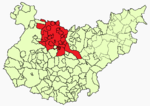Equestrian statue of Augustus (Mérida)
Bronze sculptures in SpainBuildings and structures in Mérida, SpainCultural depictions of AugustusEquestrian statues in SpainMonuments and memorials in Extremadura ... and 2 more
Outdoor sculptures in SpainSculptures of men in Spain

The equestrian statue of Augustus is a bronze statue of Augustus, the first Roman emperor, riding a horse. It dates from 2007 and is in Mérida, Spain, located on a roundabout at the intersection of the Avenida de Portugal and the Avenida Reina Sofía. Emerita Augusta, today Mérida, was founded as a Roman colony in 25 BC at the order of Augustus to serve as a retreat for the veteran soldiers (emeritus) of the legions V Alaudae and X Gemina.
Excerpt from the Wikipedia article Equestrian statue of Augustus (Mérida) (License: CC BY-SA 3.0, Authors, Images).Equestrian statue of Augustus (Mérida)
Mérida Polígono Industrial Cepansa (Distrito 6)
Geographical coordinates (GPS) Address Nearby Places Show on map
Geographical coordinates (GPS)
| Latitude | Longitude |
|---|---|
| N 38.904871 ° | E -6.364105 ° |
Address
06808 Mérida, Polígono Industrial Cepansa (Distrito 6)
Extremadura, Spain
Open on Google Maps










